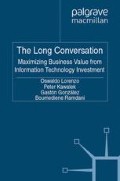Abstract
The “Long Conversation” comprises three vital points of learning and development. Each point tends to create emergent complexity that can set the implementation back and reorient it away from its original focus and motivate more group-learning. They are as follows: osmosis, growth and adaptation (see Figure 3.1). Placing these three vital points together is what makes for information technology mastery, something that relies on the formal and informal sharing of knowledge about technology and the affected processes and structures.1
Access this chapter
Tax calculation will be finalised at checkout
Purchases are for personal use only
Preview
Unable to display preview. Download preview PDF.
Notes
This classifying of the use of information systems into different categories is not a new in IS literature. Zuboff, in her pioneering study In the Age of the Smart Machine: The Future of Work and Power (New York: Basic Books, 1988) defined two roles for IT: automating and informating. According to Zuboff, when IT automates, it rationalizes work and decreases dependence on human skills; whereas IT informates when it generates vast amounts of information about the underlying business processes and generates a kind of knowledge that allows better participation and relationships. Hence, ES automates business processes so that these processes can be performed with more continuity, uniformity, control and less dependence on human discretion (i.e., ES transaction automation capability); whereas ES informates when it generates information that improves decision-making processes (i.e., ES decision support capability), integration among different business areas (i.e., ES coordination capability) and service to internal and external customers (i.e., ES customer service capability).
More recently, Davenport in his book Mission Critical: Realizing the Promise of Enterprise Systems (Boston, MA: Harvard Business School Press, 2000) describes several areas of functionality (i.e., actual use) into which ESs may grow. These areas are based on a more sophisticated function for information processing. Hence the informating category by Zuboff evolves toward more advanced concepts related to process management and knowledge management. The ES capabilities of process management automation and monitoring performance capture these more advanced uses as defined by Davenport. Of course, and also argued by Davenport, all these models, classifications, or concepts are not immutable natural laws, as ES is an inherently evolving technology.
This framework relies upon Malone and Crowston’s definition of coordination as “managing dependencies” (See T. Malone and K. Crowston, “The Interdisciplinary Study of Coordination,” ACM Computing Surveys, 1994, 26 [1], 87–119). In other words, coordination is seen as a response to troubles caused by dependencies. Typical dependencies that may be handled by ES are those defined by Crowston as “share resource” and “producer-consumer” (See K. Crowston, 2001 “A Taxonomy of Organizational Dependencies and Coordination Mechanisms,” MIT Papers). In the ES context, share resource can be seen as sharing the same body of information between different departments or business units that require it simultaneously. Producer-consumer is concerned with synchronizing activities or processes embedded in a value chain so that the resource required by the consumer is available when needed.
The sophistication of this capability has evolved over time. Sophisticated algorithms and operations research techniques have been lately embedded inside the ES. In some cases, this has been possible through the development of bolt-on applications by third-party vendors. MRP (Materials Requirements Planning) and DRP (Distribution Requirements Planning) are examples of management techniques supported by ES. The most sophisticated ES provides automated supply chain management (SCM). E.g., the Advanced Planner and Optimiser (APO) functionality by SAP. MRP/DRP techniques have been developed as sophisticated, computerized planning tools that aim to make the necessary materials or inventory available when needed. The concept originated with MRP, an inventory control technique for determining dependent demand for manufacturing supply. Subsequently, manufacturing resource planning (MRP II) was developed with the objective of improving productivity through the detailed planning and control of production resources. MRP II is based on an integrated approach to the whole manufacturing process from orders through production planning and control techniques to the purchasing and supply of materials. DRP is the application of MRP II techniques to the management of inventory and material flow — effective warehousing and transportation support. (See more about MRP and DRP techniques in A. Rushton, J. Oxley, and P. Croucher, 2001, Handbook of Logistics and Distribution Management, 2nd Edition, London: Kogan Page.
These three levels have been characterized by using concepts and terms that have been borrowed from (i) P. Bocij, D. Chaffey, A. Greasley and S. Hickie, Business Information systems: Technology Development and Management, London: Pitman, 1999; (ii)
M. Markus, “Paradigm Shifts — E-Business and Business/Systems Integration,” Communications of the Association for Information Systems, 2000, 4 (10), and (iii) T. Davenport, Mission Critical: Realizing the Promise of Enterprise Systems, Boston, MA: Harvard Business School Press, 2000.
The presence of adaptation processes of technologies-in-use is not new in innovation and IS experiences. E.g., Tyre and Orlikowski (M. Tyre and W. Orlikowski. “Windows of Opportunity: Temporal Patterns of Technological Adaptation in Organizations,” Organization Science, 5[1], 98–117) use the term “technological adaptation” to refer to the adjustments and changes following installation of a new technology. In addition, Leonard-Barton (D. Leonard-Barton, “Implementation as Mutual Adaptation of Technology and Organization,” Research Policy, 1988, 251–267) points out that the adaptation process “is precipitated by implementation misalignments — mismatches between the technology and the organization recognized at the time of initial or trial use” (p. 255). She calls it as “mutual adaptation.”
Author information
Authors and Affiliations
Copyright information
© 2011 Oswaldo Lorenzo, Peter Kawalek, Gastón González & Boumediene Ramdani
About this chapter
Cite this chapter
Lorenzo, O., Kawalek, P., González, G., Ramdani, B. (2011). Biological evolution: Osmosis, growth and adaptation. In: The Long Conversation. IE Business Publishing. Palgrave Macmillan, London. https://doi.org/10.1057/9780230337190_3
Download citation
DOI: https://doi.org/10.1057/9780230337190_3
Publisher Name: Palgrave Macmillan, London
Print ISBN: 978-1-349-33426-1
Online ISBN: 978-0-230-33719-0
eBook Packages: Palgrave Business & Management CollectionBusiness and Management (R0)

